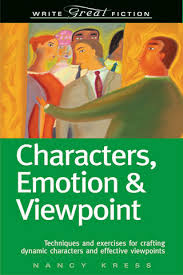By Sadie Scapillato

I picked up Characters, Emotion & Viewpoint by Nancy Kress because I was working on a manuscript by a newish writer who wanted guidance on how to handle multiple third person points of view. A writer friend of mine recommended the Write Great Fiction series by Writer’s Digest. It had just what I needed and more.
In this post, I’d like to give you a few good reasons to check out Characters, Emotion & Viewpoint, because I think it has a lot to offer. Although this book is written for writers, I as a fiction editor still found it incredibly useful because it breaks down important elements of fiction (characterization and point of view) and serves as a great reference tool or starting point for decisions and discussions on editing choices and recommendations.
Top five reasons to check out this title
1. Great content on point of view (POV)
Because my goal in buying Characters, Emotion & Viewpoint was to refresh my memory on POV, I devoured that section of the book. The chapters in this section talk about writing from different points of view and offer advice for choosing the best point of view for your story. For example, Chapter 13 on first-person POV reminds readers that “everything in writing is a trade-off” (page 175). In other words, choosing one POV may mean having to give up some of the writing techniques available in the other viewpoints.
I also enjoyed the characterization section of the book, but the writer I was working with at the time needed guidance on POV more than on developing characters, so I spent much more time on the POV section and can recommend it with much more confidence.
2. Helpful recaps, set-off passages, and appendix
I love a well-organized reference book. This one has chapter-end recaps (always a good idea if you ask me), set-off passages that provide extra information on the chapter topic (e.g. there’s a set-off passage called “Characters Laughing” in Chapter 11, “The Humorous Character—All Bets Are Off”), and a great appendix that provides a checklist of critical points covered in the book. Writers (and editors) might also like the “Mini-Bio for Key Characters” template on page 16.
3. Descriptive titles, tidy table of contents, and good index
The chapter titles and subtitles give readers a good idea of what to expect in a given section. For example, the title of Chapter 4 is “The Motivationally Complicated Character—But I’m a Mess Inside!” Appropriately, this chapter talks about writing complicated characters. I also appreciate the easy-to-read, cleanly formatted table of contents and index.
4. Useful exercises
This book has plenty of opportunities to practice for the hands-on, exercise-loving learner. I have to admit that I haven’t done all that many of the exercises myself, but I take comfort in knowing that they’re there in case I should decide to get my hands dirty. Here’s a good one from the end of Chapter 10 (“Special Cases of Emotions—Loving, Fighting, and Dying”): “Find a love scene you think works in a novel or short story. Does it mix love with any other emotion or concern? What?”
5. Lots of examples from published novels (and now my reading list is even longer!)
So. Many. Suggested. Reads. My to-read list grew quickly as I read through this book. I love that Kress refers to published works for examples of the concepts she is explaining. This is great because it gives the reader a bunch of suggested titles to pick up to see what they’ve learned in action. For example, she refers to the first three-quarters of Faulkner’s The Sound and the Fury as an example of multiple first person narration.
A quick note on the reading format: I bought the hard-copy version of this book because I knew I would want to highlight and annotate extensively. Unfortunately, when I was buying the series I was only able to purchase an ebook version of Revision and Self-Editing. I found it much less enjoyable to work with this type of reference book as an electronic resource and highly recommend purchasing the print copy instead.
Further reading
If you like this book, you’ll probably enjoy the other four titles from the Write Great Fiction series:
- Dialogue by Gloria Kempton
- Description & Setting by Ron Rozelle
- Plot & Structure by James Scott Bell
- Revision and Self-Editing by James Scott Bell
I couldn’t resist—I bought all five.
After my writer friend recommended the series to me, I’ve been recommending these titles to other writers who email me looking for reference tools for improving their craft and revising their manuscripts. I think other editors (especially newer kids on the block, like me) will also find much to learn in this handy series.
Thanks for reading, and happy fiction editing!
Sadie Scapillato is a freelance editor and French-to-English translator in Hamilton, Ontario. Follow Sadie on Twitter @cibliste.

Nice review. Nancy Kress is an excellent writer. I’m currently reading the January 2014 issue of Asimov’s Science Fiction, in which she has a story.
LikeLike
Thanks Rob! I haven’t actually read any of her fiction, but will add her to my list thanks to your recommendation. Any suggestion on which work to start with?
LikeLike
I really enjoyed her novel Beggars in Spain. She is an excellent short story writer, so any collection of stories by her would be worthwhile. I’ve been reading her stories for years as they are published in sci-fi magazines.
LikeLike